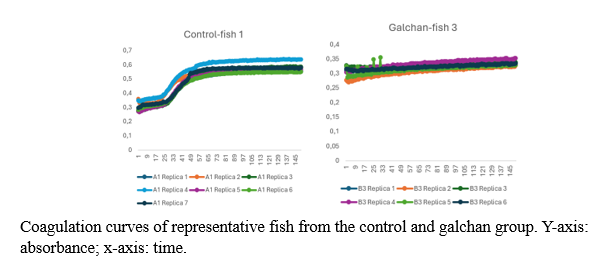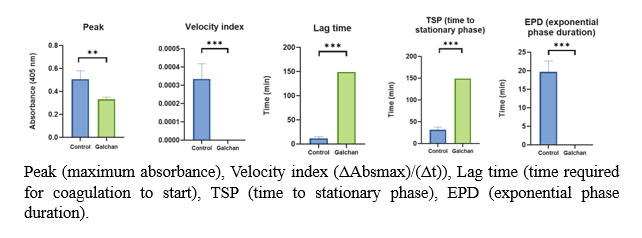CLOT FORMATION ASSAY (CFA): A NOVEL METHOD FOR ASSESSING PLASMA CLOTTING CAPACITY IN GILTHEAD SEABREAM Sparus aurata
Introduction
Aquaculture has experienced significant growth in both production volume and economic impact on a global scale. The incidence of disease outbreaks in farmed fish is anticipated to increase as a consequence of climate change, underscoring the necessity to improve diagnostic methods for these aquatic organisms.
The implementation and validation of standardized, non-lethal, and cost-effective techniques for monitoring fish health are imperative. While hematological analysis in humans is a well-established diagnostic tool, offering a clear correlation between patients’ real-time health status and their causative factors, fish hematology is emerging as a valuable biomarker system. The literature emphasizes its ability to detect acute and chronic pathophysiological changes induced by nutritional deficits, environmental stressors, water quality deterioration, toxic agents, and pathological conditions. This work addresses the development of a new standardized assay designed to enable the correlation of coagulation with the health status of gilthead seabream (Sparus aurata).
Materials and methods
To standardize the assay, it was necessary to determine the concentration of sodium citrate required to prevent coagulation in sea bream blood, as well as the concentration of calcium chloride needed to initiate the reaction. Blood samples of 250 µl from gilthead sea bream were collected in 1.5 ml Eppendorf tubes containing the predetermined concentration of sodium citrate and maintained on ice. These samples were centrifuged at 2500g for 15 minutes to obtain cell-free plasma (CFP), which could subsequently be stored at -40°C. Samples consisting of 150 µl Braun Physiological Serum 0.9%, 40 µl PLC, and 10 µl calcium chloride were placed in 96-well, clear, flat-bottomed, untreated plates. Due to the variability in the initial data, numerous replicates were conducted to validate the results. Sodium citrate concentrations ranging from 3.8% to 20% were tested, and calcium chloride concentrations from 0 to 350 nM were evaluated. Following the prevention of clotting, absorbance was recorded at 405 nm for one hour, with measurements taken at one-minute intervals. This assay was applied to blood from different groups of fish: a control group injected with phosphate buffer, an azidated group injected with an azidated sugar, and a galchan group exposed to chitosan for one hour before being injected with the azidated sugar. All animals were sampled eight hours post-injection.
Results
The 15% sodium citrate and 200 mM calcium chloride were selected as the best concentration to obtain the expected results.
Discussion/conclusions
The findings indicate substantial differences between the control group and the two experimental groups across all examined parameters, underscoring the galchan group’s inability to induce coagulation under conditions identical to those of the control group. The primary objective is to utilize this assay in investigating the immunity of sea bream, as the procoagulant capacity of plasma has been associated with acute stress, potentially leading to mortality in fish through spontaneous thrombus formation due to elevated circulating adrenaline levels. In teleost, the anticoagulant capacity of plasma has been linked to liver damage, resulting in a reduced blood concentration of proteins involved in coagulation. In the absence of liver damage and hypocoagulability, it is proposed that the compounds evaluated in this assay may act as protective agents against thrombus formation. Based on the results, chitosan may serve as a protective compound against thrombus generation when liver damage is not present.
Acknowldegements
This research has been funded by the research project PID2020-113637RB-C21 funded by MCIN/AEI/10.13039/501100011033 and is part of the ThinkInAzul programme supported by MCIN with funding from the European Union Next Generation EU (PRTR-C17.I01) and by the Comunidad Autónoma de la Región de Murcia - Fundación Séneca which also funds María Ortiz’s pre-doctoral scholarship (22303/FPI/23).
References
M. Ortiz, M.Á. Esteban, Biology and functions of fish thrombocytes: A review, Fish Shellfish Immunol. 148 (2024) 109509. https://doi.org/10.1016/j.fsi.2024.109509.
M. Tavares-Dias, S. Oliveira, A review of the blood coagulation system of fish, Braz J Biosci 7 (2009) 205–224. https://www.researchgate.net/publication/291448920

